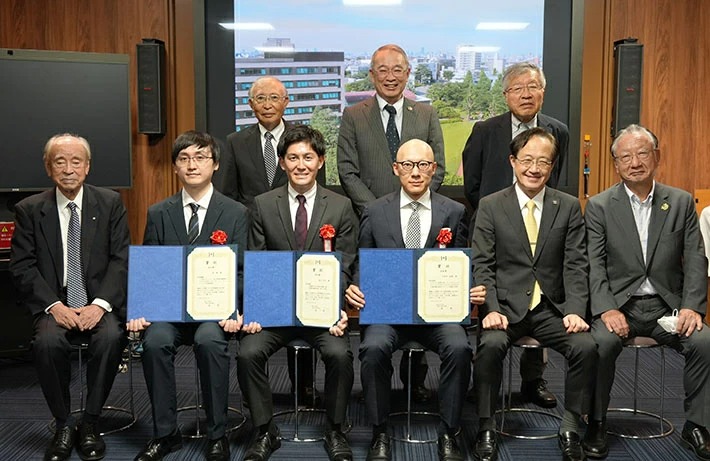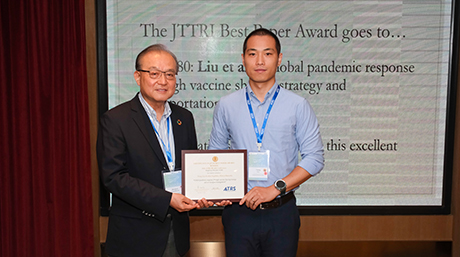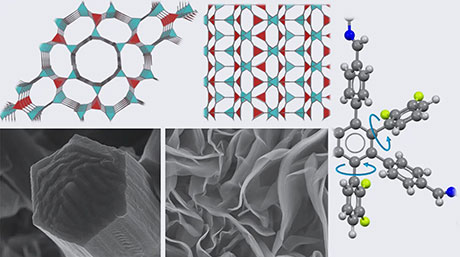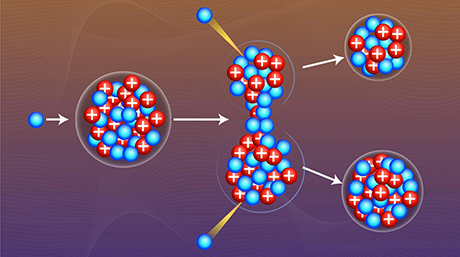Transdisciplinary Science and Engineering News
2022 Suematsu Award ”Fundamentals and Developments of Digital Technology” Winners Announced -Assist. Prof. Hang SONG won the award -
Three Tokyo Tech young researchers, including Assistant Professor Hang SONG, were awarded the 2022 Suematsu Digital Technology Award and a ceremony was held on September 1.
The Suematsu Digital Technology Award was established in 2018 to provide a broad range of support for young researchers and their work in areas such as computers, robotics, networks, and the application of digital technology.
Attending the ceremony were: the three award winners, President Kazuya Masu, Executive Vice President for Research Osamu Watanabe, Honorary Professor Yasuharu Suematsu, Chairman and Director of Gurunavi Inc. Hisao Taki, President of National Agriculture and Food Research Organization Kazuo Kyuma, NEC Corp. Executive Advisor Nobuhiro Endo, Professor Emeritus Katsuhisa Furuta, Fumio Honbo of the Tokyo Tech Alumni Association (Kuramae Kougyoukai), and the Executive Assistant to the President.

Memorial photo of the ceremony(Hang SONG(second from left in front row))
2022 Suematsu Award "Fundamentals and Developments of Digital Technology" Recipients
Assistant Professor Hang SONG
Department of Transdisciplinary Science and Engineering , School of Environment and Society
, School of Environment and Society
Research Topic: Radio propagation analysis of mmWave to THz-wave and development of sub-surface imaging technology
As a non-invasive technique, the radio wave has been widely studied for medical usages such as abnormal tissue detection and bio-imaging. However, the used frequencies mainly concentrate on several GHz which limit the resolution of the measurement. Recently, the development of communication technologies with mmWave and THz-wave has evolved rapidly. Meanwhile, since the wavelength is short, it is promising to be utilized to realize high-resolution imaging. In this research, the mmWave and THz-wave propagation inside the human will be comprehensively analyzed and the emerging machine learning technologies will be exploited to figure out the relationship between internal structure and wave propagation characteristics. Then, algorithms will be developed to reconstruct the sub-surface structure with high accuracy. In the future, this research aims at developing the fundamental technology for high-resolution sub-surface imaging towards biomedical application.
Assistant Professor Yohei AIKAWA
Laboratory for Future Interdisciplinary Research of Science and Technology , Institute of Innovative Research
, Institute of Innovative Research
Research Topic: A study on low-latency logical circuit based on optical likelihood calculation
Today's digital society has been supported by electrical circuits made of complementary metal oxide semiconductor (CMOS). However, as circuits become smaller, processing delays increase, which is a major problem. To solve this problem, there is an effort to introduce optical signal processing in electrical circuits. This approach is expected to improve processing delay as the size of the circuits become smaller, since the processing is completed as light signal propagates through the circuit. Based on the background, the author has been engaged in research on optical likelihood calculations and has succeeded in realizing its operation. This research applies the calculation technology to logic circuit. In particular, the author approaches the input-output relationship of the circuit as likelihood calculation. This will enable optics and electrons to share processing in a suitable manner and is expected to open the way to lower latency digital technology.
Assistant Professor Takamasa KAWANAGO
Laboratory for Future Interdisciplinary Research of Science and Technology , Institute of Innovative Research
, Institute of Innovative Research
Research Topic: Ultralow-Voltage Design and Device Technology of WSe2 CMOSFET for Energy Efficient Digital Electronics
Digital electronics based on silicon (Si) semiconductors is the fundamentals of modern society, and further development is necessary in the future. However, miniaturization of semiconductor device, which is the guiding principle of performance improvement, has reached its essential limit. Once miniaturization is completed, performance will improve by only 3% per year. Furthermore, a significant increase in the energy consumption of semiconductor devices due to a rapid increase in the amount of information communication is an urgent issue on a global scale. Therefore, tungsten diselenide (WSe2), which has no dangling bonds and exhibits high mobility of electrons and holes exceeding that of Si even with a single molecular layer and ambipolar conduction, has attracted much attention as a semiconductor to replace Si. The purpose of this study is to establish the device technology of WSe2 CMOSFET and to realize digital electronics with high energy efficiency by ultra-low voltage operation. By independently establishing source/drain technology with alloy and compound metals and self-aligned gate stack technology, a CMOS inverter gain of 15 at low voltage 0.5V operation will be demonstrated.
At the ceremony to present the recipients with their award notices, the researchers gave presentations on their respective research topics. This was followed by Q&A and words of encouragement from Honorary Professor Suematsu and other attendees.
About the Suematsu Award "Fundamentals and Developments of Digital Technology"
Former Tokyo Tech President and Honorary Professor Yasuharu Suematsu was awarded the Japan Prize in 2014 for his contributions to the development of high-capacity, long-distance optical fiber communications through his research at the Institute, particularly his groundbreaking research related to dynamic single-mode lasers. He donated a portion of the prize money to Tokyo Tech in hopes of encouraging young scientists and engineers to pursue research in diverse fields, develop new technology systems, and delve into the unexplored domains of science.
Suematsu hopes to create a rising tide of activities that will reveal the now-hidden shape of the future. The Tokyo Institute of Technology Fund created the Suematsu Fund to promote research in line with Suematsu's wishes. President and Representative Director Hisao Taki of Gurunavi Inc., a Tokyo Tech alumnus and supporter of the Tokyo Institute of Technology Fund since its inception, also donated a significant additional sum, making the creation of this award possible.
- Suematsu Award "Fundamentals and Developments of Digital Technology" | Office of Research and Innovation
- Areas of Support | Tokyo Institute of Technology Fund
- 2021 Suematsu Award "Fundamentals and Developments of Digital Technology" Winners Announced | Tokyo Tech News
- Takada Laboratory
- Global Engineering for Development, Environment and Society Graduate Major|Education|Department of Transdisciplinary Science and Engineering, School of Environment and Society
Tokyo Institute of Technology iGEM is supported by Tokyo Tech Fund
Further Information
General Affairs Group, Research Planning Division






